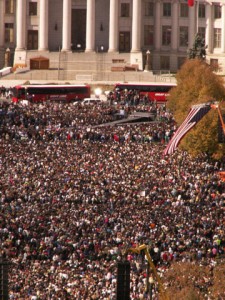By the end of the week, my family and friends around the world won’t ask me “where is it?” when I tell them I live in Denver.
In a few hours, the Democratic National Convention will start in a city that last year had over 12 million overnight visitors. Still, Denver is not, yet, as famous as New York, Chicago, Dallas or Los Angeles.
But with its beautiful architecture and nature, Colorado’s capital and largest city Denver will quickly win hearts. The nearby Red Rocks, the beautiful State Capitol (where I work), yummy restaurants and cozy bars offer locals and visitors exceptional pleasure and leisure.
Dating back to 1858, Denver is a century and a half old. It became the state capital after Golden and Colorado City lost their bid. It was a simple decision – Denver had more women than any other city in the state.
More women – more rights. In 1893, women in Colorado won their right to vote – only the second in the nation. In 1894, three women were elected to serve in the House of Representatives. Before them, no woman had served as a senator or representative anywhere else in the United States.
In 1908, when the Democratic National Convention met in Denver for the first time, women were allowed to be delegates at the convention for the first time. It wasn’t until 1920, though, when the federal government extended the right to vote to all women.
Along with progressive history, Colorado has darks sides too. In 1864, Colorado volunteers (who thought they were fighting in the Civil War) exterminated an entire peaceful camp of Native Americans at Sand Creek. And in the 1920s, Colorado’s governor was a member of the Ku Klux Klan.
With a diverse history, Colorado isn’t ethnically very diverse. Denver is the exception, where along with white Americans you will see Americans from all races and of all countries. Perhaps this diversity is what makes Denver so hospitable. Hospitality in Denver is almost as good as in Armenia.
Speaking of Armenians, many people get surprised when they find a quarter-century-old Armenian Genocide monument-plaque at the Colorado State Capitol. And although the Armenian community is not very large (perhaps 4,000 in and around Denver), its roots are very old.
Once I came across to a January 27, 1884, article in the local Rocky Mountain News. It talked about four Armenians, originally from what is now eastern Turkey, who had come from Italy. In Denver, they had become merchants. But in their hearts, they had always stayed Armenians and dreamed of returning to their homeland. Their hope was to return to Armenia: “My brother feels as I do, that in our own beautiful land in Asia Minor lies our destiny and it may be that near our old home we shall find at last the ancient site of Eden.”
Had they returned to Armenia, they would have been killed either in the Hamidian massacres or in the Genocide of 1915. I don’t know if they returned or not.
A number of Armenian friends – many of them with the media – are visiting Denver for the Convention this week. Voice of America is planning to interview local Armenians and guests.
I learned from the U.S. Embassy last month that Armenia had two-member delegation traveling to Denver for the Democratic National Convention.
WELCOME to all who are in Denver this week.









